Seat Altea XL 2015 Owner's Manual
Manufacturer: SEAT, Model Year: 2015, Model line: Altea XL, Model: Seat Altea XL 2015Pages: 236, PDF Size: 4.23 MB
Page 181 of 236
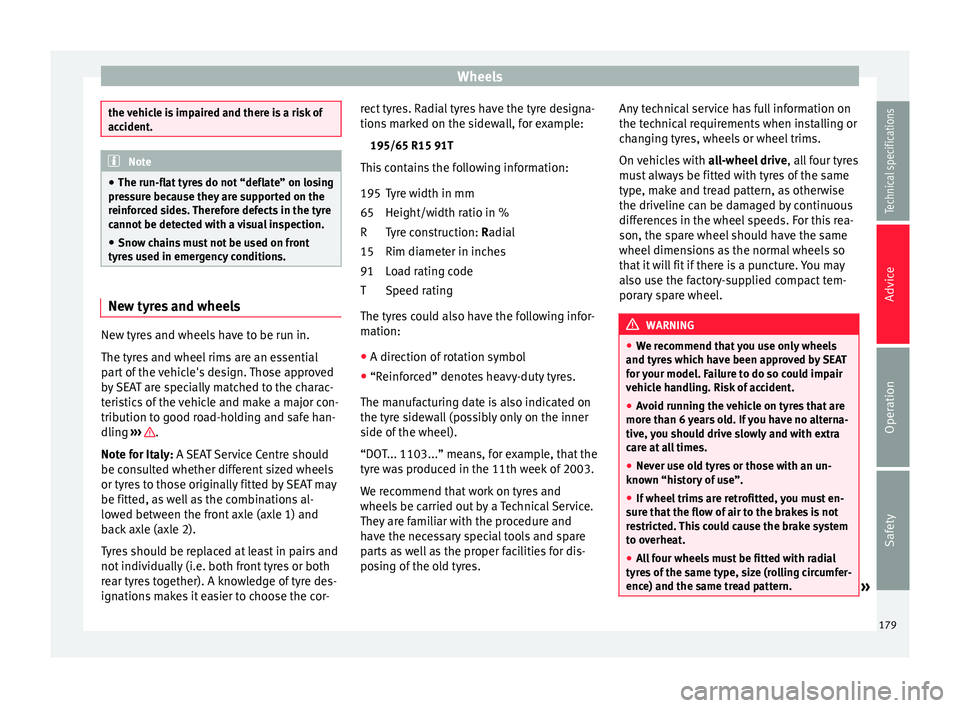
Wheels
the vehicle is impaired and there is a risk of
accident.
Note
● The run-flat tyres do not “deflate” on losing
pressure because they are supported on the
reinforced sides. Therefore defects in the tyre
cannot be detected with a visual inspection.
● Snow chains must not be used on front
tyres used in emergency conditions. New tyres and wheels
New tyres and wheels have to be run in.
The tyres and wheel rims are an essential
part of the vehicle's design. Those approved
by SEAT are specially matched to the charac-
teristics of the vehicle and make a major con-
tribution to good road-holding and safe han-
dling
››› .
Note for Italy: A SEAT Service Centre should
be c on
sulted whether different sized wheels
or tyres to those originally fitted by SEAT may
be fitted, as well as the combinations al-
lowed between the front axle (axle 1) and
back axle (axle 2).
Tyres should be replaced at least in pairs and
not individually (i.e. both front tyres or both
rear tyres together). A knowledge of tyre des-
ignations makes it easier to choose the cor- rect tyres. Radial tyres have the tyre designa-
tions marked on the sidewall, for example:
195/65 R15 91T
This contains the following information:
Tyre width in mm
Height/width ratio in %
Tyre construction: Radial
Rim di
ameter in inches
Load rating code
Speed rating
The tyres could also have the following infor-
mation:
● A direction of rotation symbol
● “Reinforced” denotes heavy-duty tyres.
The manufacturing date is also indicated on
the tyre sidewall (possibly only on the inner
side of the wheel).
“DOT... 1103...” means, for example, that the
tyre was produced in the 11th week of 2003.
We recommend that work on tyres and
wheels be carried out by a Technical Service.
They are familiar with the procedure and
have the necessary special tools and spare
parts as well as the proper facilities for dis-
posing of the old tyres. 195
65
R
15
91
T Any technical service has full information on
the technical requirements when installing or
changing tyres, wheels or wheel trims.
On vehicles with
all-wheel drive, all four tyres
must always be fitted with tyres of the same
type, make and tread pattern, as otherwise
the driveline can be damaged by continuous
differences in the wheel speeds. For this rea-
son, the spare wheel should have the same
wheel dimensions as the normal wheels so
that it will fit if there is a puncture. You may
also use the factory-supplied compact tem-
porary spare wheel. WARNING
● We recommend that you use only wheels
and tyres which have been approved by SEAT
for your model. Failure to do so could impair
vehicle handling. Risk of accident.
● Avoid running the vehicle on tyres that are
more than 6 years old. If you have no alterna-
tive, you should drive slowly and with extra
care at all times.
● Never use old tyres or those with an un-
known “history of use”.
● If wheel trims are retrofitted, you must en-
sure that the flow of air to the brakes is not
restricted. This could cause the brake system
to overheat.
● All four wheels must be fitted with radial
tyres of the same type, size (rolling circumfer-
ence) and the same tread pattern. » 179
Technical specifications
Advice
Operation
Safety
Page 182 of 236
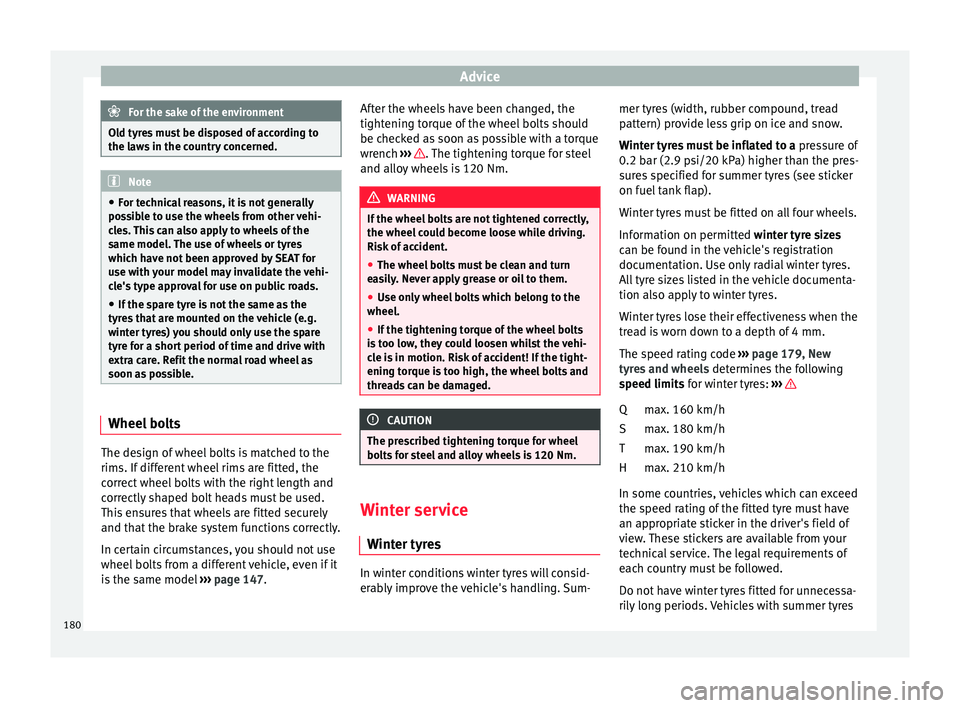
Advice
For the sake of the environment
Old tyres must be disposed of according to
the laws in the country concerned. Note
● For technical reasons, it is not generally
possible to use the wheels from other vehi-
cles. This can also apply to wheels of the
same model. The use of wheels or tyres
which have not been approved by SEAT for
use with your model may invalidate the vehi-
cle's type approval for use on public roads.
● If the spare tyre is not the same as the
tyres that are mounted on the vehicle (e.g.
winter tyres) you should only use the spare
tyre for a short period of time and drive with
extra care. Refit the normal road wheel as
soon as possible. Wheel bolts
The design of wheel bolts is matched to the
rims. If different wheel rims are fitted, the
correct wheel bolts with the right length and
correctly shaped bolt heads must be used.
This ensures that wheels are fitted securely
and that the brake system functions correctly.
In certain circumstances, you should not use
wheel bolts from a different vehicle, even if it
is the same model
›››
page 147. After the wheels have been changed, the
tightening torque of the wheel bolts should
be checked as soon as possible with a torque
wrench
››› . The tightening torque for steel
and alloy wheels is 120 Nm. WARNING
If the wheel bolts are not tightened correctly,
the wheel could become loose while driving.
Risk of accident.
● The wheel bolts must be clean and turn
easily. Never apply grease or oil to them.
● Use only wheel bolts which belong to the
wheel.
● If the tightening torque of the wheel bolts
is too low, they could loosen whilst the vehi-
cle is in motion. Risk of accident! If the tight-
ening torque is too high, the wheel bolts and
threads can be damaged. CAUTION
The prescribed tightening torque for wheel
bolts for steel and alloy wheels is 120 Nm. Winter service
Winter tyres In winter conditions winter tyres will consid-
erably improve the vehicle's handling. Sum-mer tyres (width, rubber compound, tread
pattern) provide less grip on ice and snow.
Winter tyres must be inflated to a
pressure of
0.2 bar (2.9 psi/20 kPa) higher than the pres-
sures specified for summer tyres (see sticker
on fuel tank flap).
Winter tyres must be fitted on all four wheels.
Information on permitted winter tyre sizes
can be found in the vehicle's registration
documentation. Use only radial winter tyres.
All tyre sizes listed in the vehicle documenta-
tion also apply to winter tyres.
Winter tyres lose their effectiveness when the
tread is worn down to a depth of 4 mm.
The speed rating code ››› page 179, New
tyres and wheels determines the following
speed limits for winter tyres:
›
› › max. 160 km/h
max. 180 km/h
max. 190 km/h
max. 210 km/h
In some countries, vehicles which can exceed
the speed rating of the fitted tyre must have
an appropriate sticker in the driver's field of
view. These stickers are available from your
technical service. The legal requirements of
each country must be followed.
Do not have winter tyres fitted for unnecessa-
rily long periods. Vehicles with summer tyres Q
S
T
H
180
Page 183 of 236
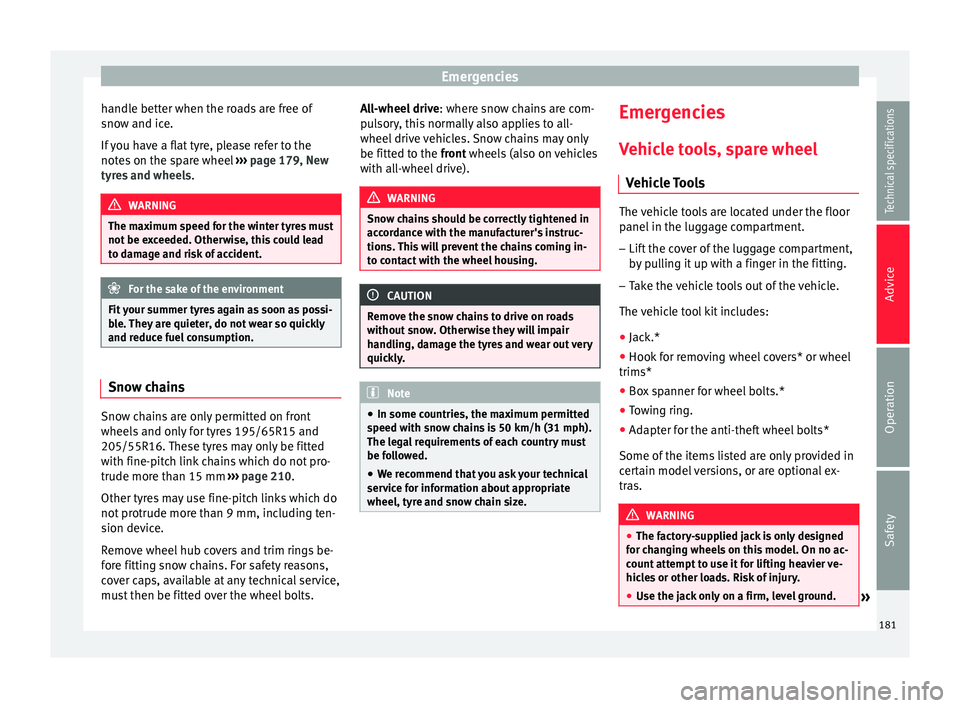
Emergencies
handle better when the roads are free of
snow and ice.
If you have a flat tyre, please refer to the
notes on the spare wheel ››› page 179, New
tyres and wheels .WARNING
The maximum speed for the winter tyres must
not be exceeded. Otherwise, this could lead
to damage and risk of accident. For the sake of the environment
Fit your summer tyres again as soon as possi-
ble. They are quieter, do not wear so quickly
and reduce fuel consumption. Snow chains
Snow chains are only permitted on front
wheels and only for tyres 195/65R15 and
205/55R16. These tyres may only be fitted
with fine-pitch link chains which do not pro-
trude more than 15 mm
›››
page 210.
Other tyres may use fine-pitch links which do
not protrude more than 9 mm, including ten-
sion device.
Remove wheel hub covers and trim rings be-
fore fitting snow chains. For safety reasons,
cover caps, available at any technical service,
must then be fitted over the wheel bolts. All-wheel drive
: where snow chains are com-
pulsory, this normally also applies to all-
wheel drive vehicles. Snow chains may only
be fitted to the front
wheels (also on vehicles
w
ith all-wheel drive). WARNING
Snow chains should be correctly tightened in
accordance with the manufacturer's instruc-
tions. This will prevent the chains coming in-
to contact with the wheel housing. CAUTION
Remove the snow chains to drive on roads
without snow. Otherwise they will impair
handling, damage the tyres and wear out very
quickly. Note
● In some countries, the maximum permitted
speed with snow chains is 50 km/h (31 mph).
The legal requirements of each country must
be followed.
● We recommend that you ask your technical
service for information about appropriate
wheel, tyre and snow chain size. Emergencies
Vehicle tools, spare wheel Vehicle Tools The vehicle tools are located under the floor
panel in the luggage compartment.
– Lift the cover of the luggage compartment,
by pulling it up with a finger in the fitting.
– Take the vehicle tools out of the vehicle.
The vehicle tool kit includes:
● Jack.*
● Hook for removing wheel covers* or wheel
trims*
● Box spanner for wheel bolts.*
● Towing ring.
● Adapter for the anti-theft wheel bolts*
Some of the items listed are only provided in
certain model versions, or are optional ex-
tras. WARNING
● The factory-supplied jack is only designed
for changing wheels on this model. On no ac-
count attempt to use it for lifting heavier ve-
hicles or other loads. Risk of injury.
● Use the jack only on a firm, level ground.
» 181
Technical specifications
Advice
Operation
Safety
Page 184 of 236
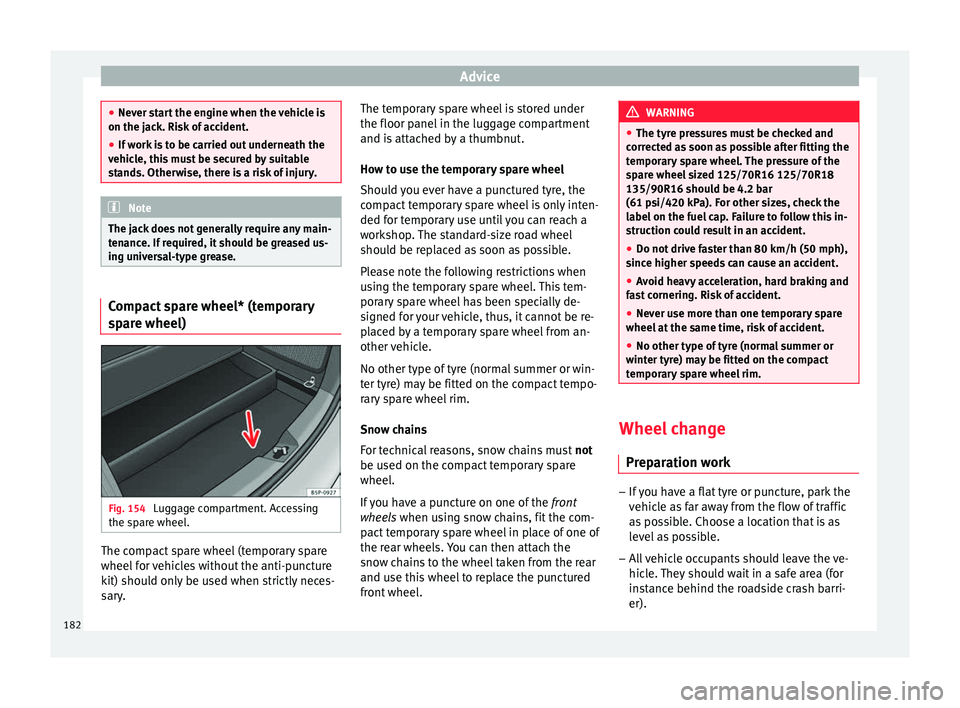
Advice
●
Never start the engine when the vehicle is
on the jack. Risk of accident.
● If work is to be carried out underneath the
vehicle, this must be secured by suitable
stands. Otherwise, there is a risk of injury. Note
The jack does not generally require any main-
tenance. If required, it should be greased us-
ing universal-type grease. Compact spare wheel* (temporary
spare wheel)
Fig. 154
Luggage compartment. Accessing
the spare wheel. The compact spare wheel (temporary spare
wheel for vehicles without the anti-puncture
kit) should only be used when strictly neces-
sary. The temporary spare wheel is stored under
the floor panel in the luggage compartment
and is attached by a thumbnut.
How to use the temporary spare wheel
Should you ever have a punctured tyre, the
compact temporary spare wheel is only inten-
ded for temporary use until you can reach a
workshop. The standard-size road wheel
should be replaced as soon as possible.
Please note the following restrictions when
using the temporary spare wheel. This tem-
porary spare wheel has been specially de-
signed for your vehicle, thus, it cannot be re-
placed by a temporary spare wheel from an-
other vehicle.
No other type of tyre (normal summer or win-
ter tyre) may be fitted on the compact tempo-
rary spare wheel rim.
Snow chains
For technical reasons, snow chains must
not
be used on the compact temporary spare
wheel.
If you have a puncture on one of the front
wheels when using snow chains, fit the com-
p act
temporary spare wheel in place of one of
the rear wheels. You can then attach the
snow chains to the wheel taken from the rear
and use this wheel to replace the punctured
front wheel. WARNING
● The tyre pressures must be checked and
corrected as soon as possible after fitting the
temporary spare wheel. The pressure of the
spare wheel sized 125/70R16 125/70R18
135/90R16 should be 4.2 bar
(61 psi/420 kPa). For other sizes, check the
label on the fuel cap. Failure to follow this in-
struction could result in an accident.
● Do not drive faster than 80 km/h (50 mph),
since higher speeds can cause an accident.
● Avoid heavy acceleration, hard braking and
fast cornering. Risk of accident.
● Never use more than one temporary spare
wheel at the same time, risk of accident.
● No other type of tyre (normal summer or
winter tyre) may be fitted on the compact
temporary spare wheel rim. Wheel change
Preparation work –
If you have a flat tyre or puncture, park the
vehicle as far away from the flow of traffic
as possible. Choose a location that is as
level as possible.
– All vehicle occupants should leave the ve-
hicle. They should wait in a safe area (for
instance behind the roadside crash barri-
er).
182
Page 185 of 236
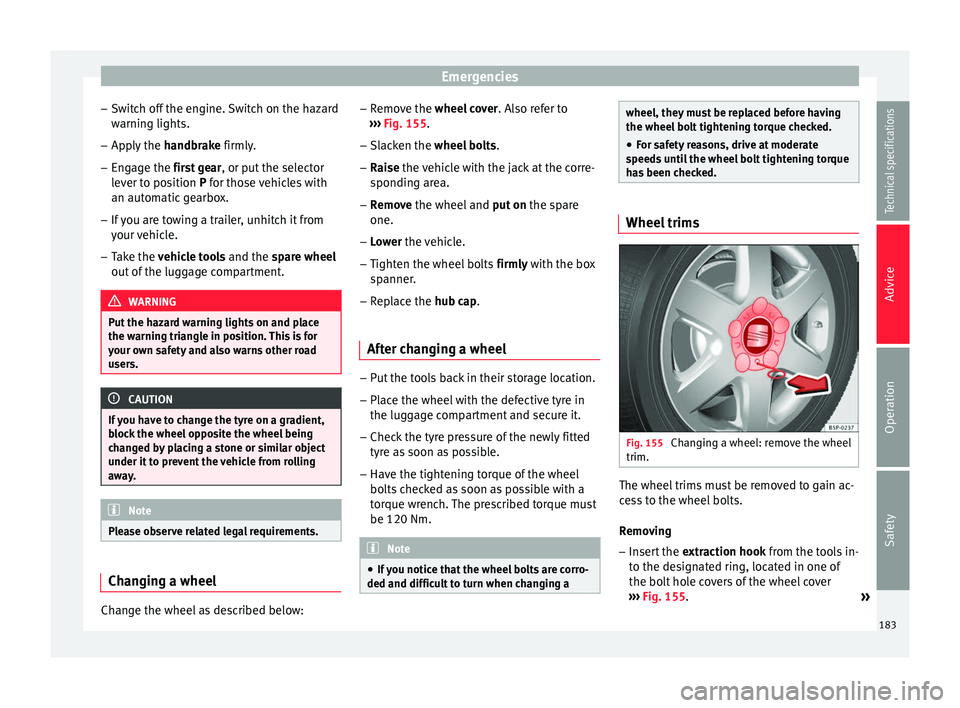
Emergencies
– Switch off the engine. Switch on the hazard
warning lights.
– Apply the handbrake firmly.
– En g
age the first gear , or put
the selector
lever to position P for those vehicles with
an automatic gearbox.
– If you are towing a trailer, unhitch it from
your vehicle.
– Take the vehicle tools and the spare wheel
out of
the luggage compartment. WARNING
Put the hazard warning lights on and place
the warning triangle in position. This is for
your own safety and also warns other road
users. CAUTION
If you have to change the tyre on a gradient,
block the wheel opposite the wheel being
changed by placing a stone or similar object
under it to prevent the vehicle from rolling
away. Note
Please observe related legal requirements. Changing a wheel
Change the wheel as described below: –
Remove the wheel cover
. A
l
so refer to
››› Fig. 155.
– Slac
ken the wheel bolts .
– Rai
se the vehicle with the jack at the corre-
spondin
g area.
– Remove the wheel and put
on the spare
one.
– Lower the vehicle.
– Tighten the wheel
bolts firmly with the box
sp
anner.
– Replace the hub cap.
Aft
er changing a wheel –
Put the tools back in their storage location.
– Place the wheel with the defective tyre in
the luggage compartment and secure it.
– Check the tyre pressure of the newly fitted
tyre as soon as possible.
– Have the tightening torque of the wheel
bolts checked as soon as possible with a
torque wrench. The prescribed torque must
be 120 Nm. Note
● If you notice that the wheel bolts are corro-
ded and difficult to turn when changing a wheel, they must be replaced before having
the wheel bolt tightening torque checked.
● For safety reasons, drive at moderate
speeds until the wheel bolt tightening torque
has been checked. Wheel trims
Fig. 155
Changing a wheel: remove the wheel
trim. The wheel trims must be removed to gain ac-
cess to the wheel bolts.
Removing
– Insert the extraction hook from the tools in-
to the designated ring, located in one of
the bolt hole covers of the wheel cover
››› Fig. 155 .
»
183
Technical specifications
Advice
Operation
Safety
Page 186 of 236
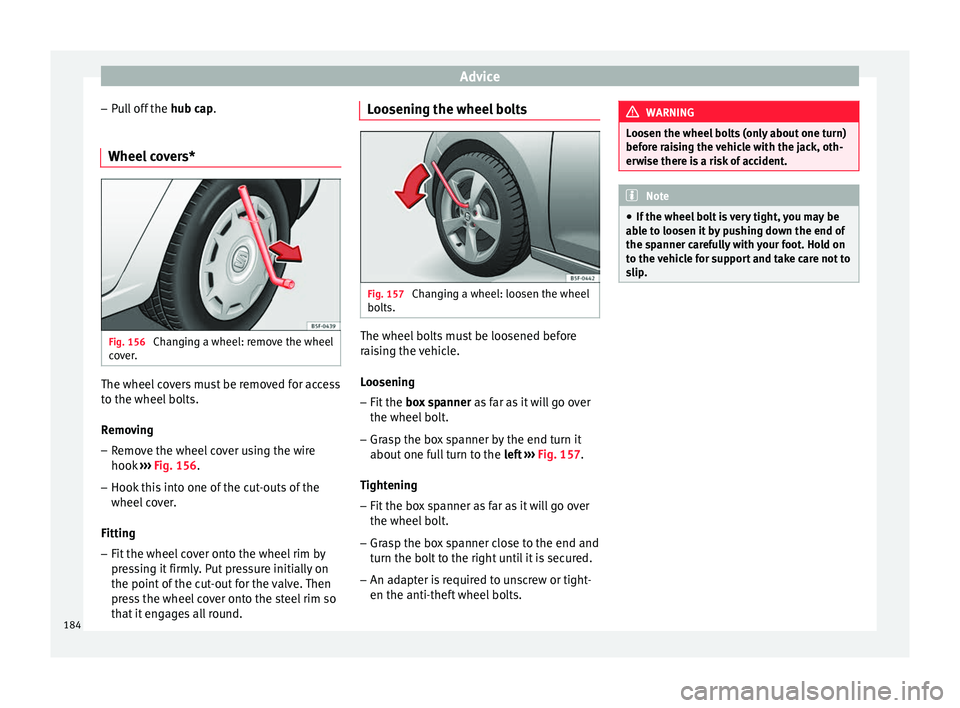
Advice
– Pull off the hub cap.
Wheel c
overs* Fig. 156
Changing a wheel: remove the wheel
cover. The wheel covers must be removed for access
to the wheel bolts.
Removing
– Remove the wheel cover using the wire
hook ››› Fig. 156 .
– Hook thi
s into one of the cut-outs of the
wheel cover.
Fitting
– Fit the wheel cover onto the wheel rim by
pressing it firmly. Put pressure initially on
the point of the cut-out for the valve. Then
press the wheel cover onto the steel rim so
that it engages all round. Loosening the wheel bolts
Fig. 157
Changing a wheel: loosen the wheel
bolts. The wheel bolts must be loosened before
raising the vehicle.
Loosening
– Fit the box spanner as far as it will go over
the wheel bolt.
– Grasp the box spanner by the end turn it
about one full turn to the left
›
›› Fig. 157.
Tightening
– Fit the box spanner as far as it will go over
the wheel bolt.
– Grasp the box spanner close to the end and
turn the bolt to the right until it is secured.
– An adapter is required to unscrew or tight-
en the anti-theft wheel bolts. WARNING
Loosen the wheel bolts (only about one turn)
before raising the vehicle with the jack, oth-
erwise there is a risk of accident. Note
● If the wheel bolt is very tight, you may be
able to loosen it by pushing down the end of
the spanner carefully with your foot. Hold on
to the vehicle for support and take care not to
slip. 184
Page 187 of 236

Emergencies
Lifting the vehicle Fig. 158
Jack position points Fig. 159
Fitting the jack. In order to remove the wheel, the vehicle
must be raised with a jack.
– Locate the jacking point under the door sill
closest to the punctured wheel ››› Fig. 158.
– Place the jack under the jacking point and
turn the crank until the arm of the jack is di- rectly below the vertical rib under the door
sill.
– Align the jack so that the arm of the jack
fits around the rib under the door sill and
the movable base plate of the jack is flat on
the ground ››› Fig. 159 .
– Rai
se the vehicle until the defective wheel
is just clear of the ground.
Recesses at the front and rear of the door
sills mark the jacking points ››› Fig. 158.
There i
s only one jacking point for each
wheel. Do not fit the jack anywhere else.
An
unstable surface under the jack may
cause the vehicle to slip off the jack. There-
fore, it must be fitted on solid ground offer-
ing good support. Use a large and stable
base, if necessary. On a hard, slippery sur-
face (such as tile) use a rubber mat or similar
to prevent the jack from slipping. WARNING
● Take all precautions so that the base of the
jack does not slip. Failure to follow this in-
struction could result in an accident.
● The vehicle can be damaged if the jack is
not applied at the correct jacking points.
There is also a risk of injury since the jack can
slip off suddenly if it is not properly engaged. Jack position points for vehicles with
sill panel trim*
Fig. 160
Plastic sill panel trim with jack an-
chor cover. Vehicles with plastic sill panel trim, with
cover*
– Remove the cap A to access the anchor
point for the vehicle jack ››› Fig. 160 .
– Pull on the cover and remove it from its al-
lotment in the direction of the arrow
››› Fig. 160 .
– Onc e the c
over has been released, it will re-
main connected to its strap so that is not
lost.
185
Technical specifications
Advice
Operation
Safety
Page 188 of 236
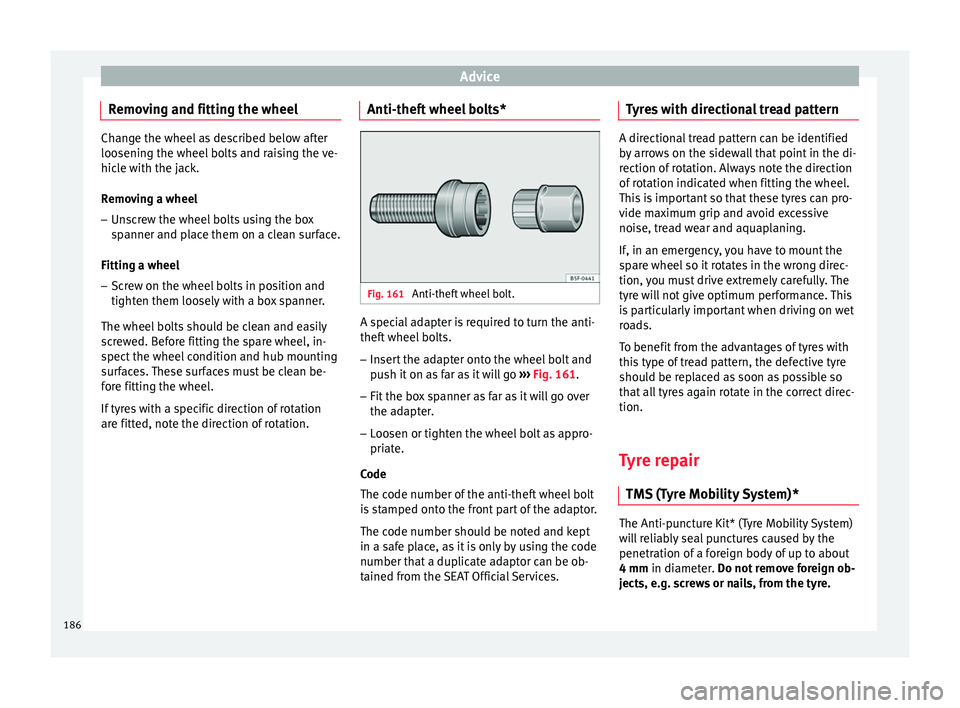
Advice
Removing and fitting the wheel Change the wheel as described below after
loosening the wheel bolts and raising the ve-
hicle with the jack.
Removing a wheel
– Unscrew the wheel bolts using the box
spanner and place them on a clean surface.
Fitting a wheel
– Screw on the wheel bolts in position and
tighten them loosely with a box spanner.
The wheel bolts should be clean and easily
screwed. Before fitting the spare wheel, in-
spect the wheel condition and hub mounting
surfaces. These surfaces must be clean be-
fore fitting the wheel.
If tyres with a specific direction of rotation
are fitted, note the direction of rotation. Anti-theft wheel bolts* Fig. 161
Anti-theft wheel bolt. A special adapter is required to turn the anti-
theft wheel bolts.
– Insert the adapter onto the wheel bolt and
push it on as far as it will go ››› Fig. 161 .
– Fit the bo
x spanner as far as it will go over
the adapter.
– Loosen or tighten the wheel bolt as appro-
priate.
Code
The code number of the anti-theft wheel bolt
is stamped onto the front part of the adaptor.
The code number should be noted and kept
in a safe place, as it is only by using the code
number that a duplicate adaptor can be ob-
tained from the SEAT Official Services. Tyres with directional tread pattern A directional tread pattern can be identified
by arrows on the sidewall that point in the di-
rection of rotation. Always note the direction
of rotation indicated when fitting the wheel.
This is important so that these tyres can pro-
vide maximum grip and avoid excessive
noise, tread wear and aquaplaning.
If, in an emergency, you have to mount the
spare wheel so it rotates in the wrong direc-
tion, you must drive extremely carefully. The
tyre will not give optimum performance. This
is particularly important when driving on wet
roads.
To benefit from the advantages of tyres with
this type of tread pattern, the defective tyre
should be replaced as soon as possible so
that all tyres again rotate in the correct direc-
tion.
Tyre repair TMS (Tyre Mobility System)* The Anti-puncture Kit* (Tyre Mobility System)
will reliably seal punctures caused by the
penetration of a foreign body of up to about
4 mm
in diameter.
Do not remove foreign ob-
j
ects, e.g. screws or nails, from the tyre.
186
Page 189 of 236
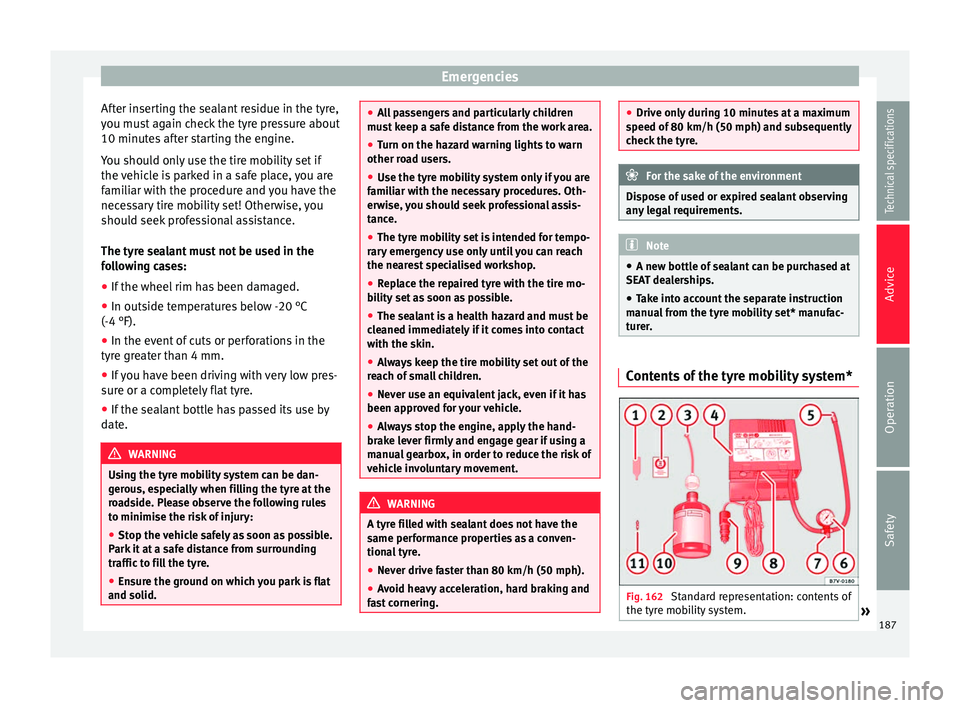
Emergencies
After inserting the sealant residue in the tyre,
you must again check the tyre pressure about
10 minutes after starting the engine.
You should only use the tire mobility set if
the vehicle is parked in a safe place, you are
familiar with the procedure and you have the
necessary tire mobility set! Otherwise, you
should seek professional assistance.
The tyre sealant must not be used in the
following cases:
● If the wheel rim has been damaged.
● In outside temperatures below -20 °C
(-4 °F).
● In the event of cuts or perforations in the
tyre greater than 4 mm.
● If you have been driving with very low pres-
sure or a completely flat tyre.
● If the sealant bottle has passed its use by
date. WARNING
Using the tyre mobility system can be dan-
gerous, especially when filling the tyre at the
roadside. Please observe the following rules
to minimise the risk of injury:
● Stop the vehicle safely as soon as possible.
Park it at a safe distance from surrounding
traffic to fill the tyre.
● Ensure the ground on which you park is flat
and solid. ●
All passengers and particularly children
must keep a safe distance from the work area.
● Turn on the hazard warning lights to warn
other road users.
● Use the tyre mobility system only if you are
familiar with the necessary procedures. Oth-
erwise, you should seek professional assis-
tance.
● The tyre mobility set is intended for tempo-
rary emergency use only until you can reach
the nearest specialised workshop.
● Replace the repaired tyre with the tire mo-
bility set as soon as possible.
● The sealant is a health hazard and must be
cleaned immediately if it comes into contact
with the skin.
● Always keep the tire mobility set out of the
reach of small children.
● Never use an equivalent jack, even if it has
been approved for your vehicle.
● Always stop the engine, apply the hand-
brake lever firmly and engage gear if using a
manual gearbox, in order to reduce the risk of
vehicle involuntary movement. WARNING
A tyre filled with sealant does not have the
same performance properties as a conven-
tional tyre.
● Never drive faster than 80 km/h (50 mph).
● Avoid heavy acceleration, hard braking and
fast cornering. ●
Drive only during 10 minutes at a maximum
speed of 80 km/h (50 mph) and subsequently
check the tyre. For the sake of the environment
Dispose of used or expired sealant observing
any legal requirements. Note
● A new bottle of sealant can be purchased at
SEAT dealerships.
● Take into account the separate instruction
manual from the tyre mobility set* manufac-
turer. Contents of the tyre mobility system*
Fig. 162
Standard representation: contents of
the tyre mobility system. » 187Technical specifications
Advice
Operation
Safety
Page 190 of 236
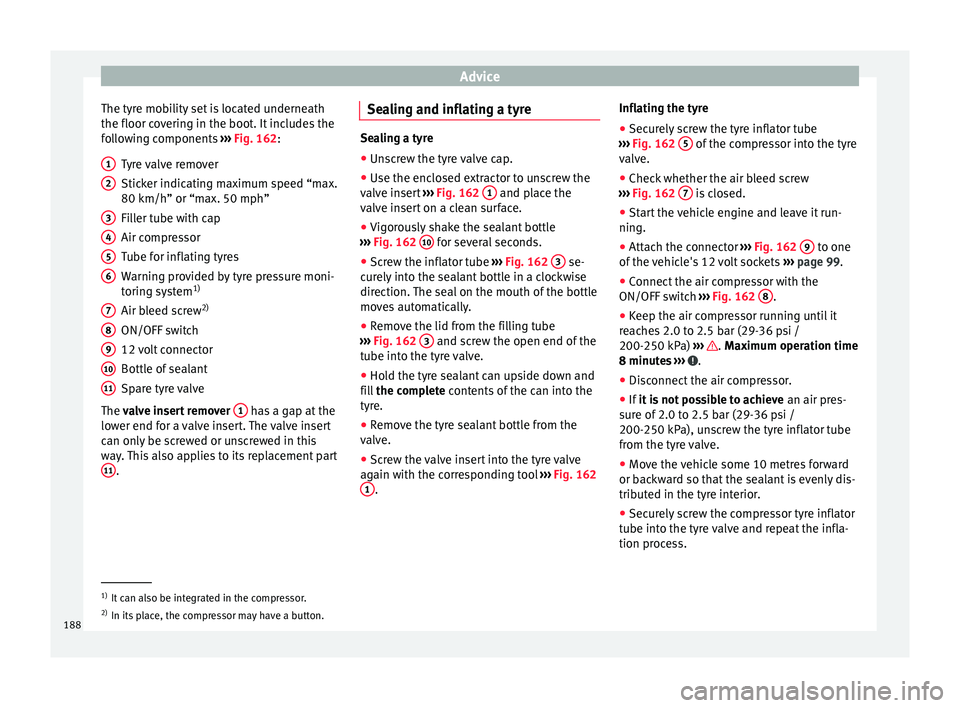
Advice
The tyre mobility set is located underneath
the floor covering in the boot. It includes the
following components ››› Fig. 162 :
T y
re valve remover
Sticker indicating maximum speed “max.
80 km/h” or “max. 50 mph”
Filler tube with cap
Air compressor
Tube for inflating tyres
Warning provided by tyre pressure moni-
toring system 1)
Air bleed screw 2)
ON/OFF switch
12 volt connector
Bottle of sealant
Spare tyre valve
The
valve insert remover 1 has a gap at the
lower end for a valve insert. The valve insert
can only be screwed or unscrewed in this
way. This also applies to its replacement part 11 .
1 2
3
4
5
6
7
8
9
10
11 Sealing and inflating a tyre
Sealing a tyre
● Unscrew the tyre valve cap.
● Use the enclosed extractor to unscrew the
valve insert ››› Fig. 162 1 and place the
valve insert on a clean surface.
● Vigorously shake the sealant bottle
››› Fig. 162 10 for several seconds.
● Screw the inflator tube ››› Fig. 162 3 se-
curely into the sealant bottle in a clockwise
direction. The seal on the mouth of the bottle
moves automatically.
● Remove the lid from the filling tube
››› Fig. 162 3 and screw the open end of the
tube into the tyre valve.
● Hold the tyre sealant can upside down and
fill the complete contents of the can into the
ty r
e.
● Remove the tyre sealant bottle from the
valve.
● Screw the valve insert into the tyre valve
again with the corresponding tool ›››
Fig. 162
1 .Inflating the tyre
●
Securely screw the tyre inflator tube
››› Fig. 162 5 of the compressor into the tyre
valve.
● Check whether the air bleed screw
››› Fig. 162 7 is closed.
● Start the vehicle engine and leave it run-
ning.
● Attach the connector ››› Fig. 162 9 to one
of the vehicle's 12 volt sockets ››› page 99.
● Connect the air compressor with the
ON/OFF switch ››› Fig. 162 8 .
● Keep the air compressor running until it
reaches 2.0 to 2.5 bar (29-36 psi /
200-250 kPa) ››› .
Maximum operation time
8 minut e
s ››› .
● Disconnect the air compressor.
● If it is not possible to achieve an air pres-
sure of 2.0 to 2.5 bar (29-36 psi /
200-250 kPa), unscrew the tyre inflator tube
from the tyre valve.
● Move the vehicle some 10 metres forward
or backward so that the sealant is evenly dis-
tributed in the tyre interior.
● Securely screw the compressor tyre inflator
tube into the tyre valve and repeat the infla-
tion process. 1)
It can also be integrated in the compressor.
2) In its place, the compressor may have a button.
188